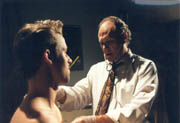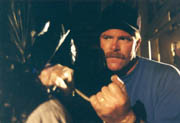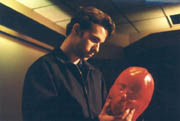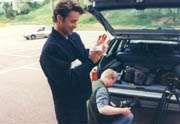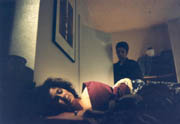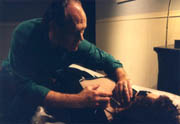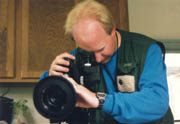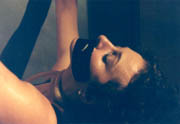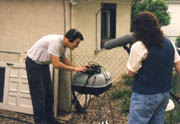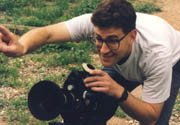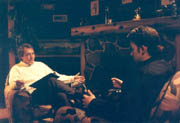
You really can make a feature film for less than Ten Grand if you keep going and avoid spending your money on unnecessary stuff. Way back in 1999 I completed a no-budget thriller called "Cathexis" and learned that making the movie is the easy part. I hope my account of the experience will help you as much as it's helped me get over it, and that you'll come away with some helpful ideas to consider in making your own no-budget movie. Let this be a cautionary tale. All the best ... Robert Gibbons
|
Like so many others, when I was young I had this dream of making a movie. I'd come across the book Feature Filmmaking at Used Car Prices by Rick Schmidt when it was first released in the late 80s, and I read it through in one long evening with a sense of, "Oh my God, this is it!" I was in my early twenties and had grandiose fantasies of being a great filmmaker. I loved filmmakers like Fellini and David Lynch and I fantasized about producing equally great work. Hell, why not? Surely the world would recognize my brilliance! I’d made a few short films, even got a few of them shown in some film festivals, including one in New York. The first time in the city, I flew in from Colorado, stayed with friends in the Village and saw my short “Down in There” projected on a big screen at the New School in lower Manhattan. I thought, this is so cool! Back at home, Rick Schmidt’s book continued to be an inspiration. Some of the technical advice sounded a bit nutty but what really turned me on was his point that if you just start doing it you really can make your own movie. Even the still pictures in the book captured my imagination. I looked at them again and again and read the chapters over and over. He said you just have to keep moving forward and never give up and someday you too can finish a feature film. Ten years later I learned that he was right when I did just that. It really can be done, though it doesn’t always turn out how you’d planned. After seeing my short film screened in New York City I decided I wanted to live there. No one had told me about summers in New York and like an idiot I moved in the middle of July and stayed on my friends’ sofa. I had a feeling of doom almost from the start and realized that I was in this huge city without a job or a permanent place to stay and without knowing anyone except for my friends who no doubt were concerned about how long I would be sleeping there. I started to become depressed and knew I had to do something. I found a sublet to stay in and after a couple sweaty and demoralizing months looking for work, I got a job as a security guard at the Metropolitan Museum of Art. I didn’t know it at the time, but this job would later become the starting point for my sure-to-be-brilliant feature film, "Cathexis." My stay in New York only lasted a year but back in Colorado I worked on a script about a guy working as a security guard who finds himself growing increasingly kinky and wonders, "What’s up?" It was embarrassingly autobiographical, since in real life I was a worried and insecure guy who had a thing for women’s clothes: I was a thoroughly-closeted transvestite and didn’t feel comfortable about it at all. So here was this script about a guy (named Gordon Lyle) dealing with a sexual situation that he didn’t feel comfortable with either. He wasn’t a crossdresser, since that would have hit way too close to home. Instead I put in all this stuff about bondage and suffocation, but it was all pretty atmospheric and never really spelled out what was really going on. Even now I’m still not completely sure what his problem was, so clearly we were operating in the land of vague. On top of the symbolic sexual stuff I made up an overly complicated plot involving a dark conspiracy with lots of secretive creeping around. It was pretty lame but at the time I didn’t realize it. I thought it would make a fantastic feature film and I decided that I was going to do it, just like Rick Schmidt said you could. I fiddled around with the script some more and enlisted friends and local theater folk to help me out. I’m not sure that everyone was too thrilled with the story but the overall attitude was, Well sure, Robert, if that’s what you really want to do…. Thankfully I’d already worked on several short films with my good friend Jim Arthurs. We were both bitten with the movie-making bug and for a few years had taken turns making shorts. Jim knew a lot more about technical matters than I did. I knew I didn’t have the confidence to operate the camera myself so I was really lucky when he signed on as the Director or Photography. In real life he also does free-lance work on computer animation, digital compositing and online editing – skills which I gladly took advantage of. Without Jim's incredibly generous help the look of the finished film would have suffered greatly. I put up an ad in the paper for an audition and spent a long day in a borrowed studio space taping various local actors on a little Hi8 camera. I had friends we’d worked with on previous shorts in mind for some of the parts but still had no one for the main guy, who was onscreen for the majority of the film. Thankfully Dustin Shapard showed up at the rehearsal and when he did his reading I thought, that's the guy. He was very natural and low-key and didn’t have that typical over-the-top community theater acting style. Dustin agreed to do the film for hardly any money at all. I gave some of the actors very small amounts of money to work on the film - just nominal sums as a thank you gesture. All together I paid less than seven hundred dollars for everyone in the cast and crew. Looking back I probably could have paid even less and still have done it. Many people love the idea of making a movie and will work for free. Of course, it’s a good idea to feed people - nothing fancy but some occasional meals to keep everyone from walking off the set when they grow faint. Another long-time friend of mine, Kathleen MacNally, did a lot of the catering for us and allowed me to shoot a good portion of the movie in her duplex. So where did the money come from anyway? Well, it was the usual routine: saving up money from my day job (doing set building and construction), investments from now-regretful family members and especially borrowing from the good folks at Chase Visa. The production itself actually went surprisingly smoothly. There were very few crises or blow-ups during the shoot. I think Jim and I sometimes growled a little at each other but overall it was a very even-tempered shoot. No one quit and walked off and no one got hurt. We’d shoot whenever we could make everyone’s schedule work, often on weekends. The whole shoot was off and on during the summer of ’97 but all told only added up to about fifteen days. It was very stressful for me, since I basically had to make the thing happen and didn’t have the kind of personality that enjoyed motivating people. But I did the best I could, vomited from nerves a few times early in the mornings when I woke up, and muddled through okay. Some of the most disappointing moments were when we’d be in the middle of shooting a scene and I could tell that it just wasn’t working. Either the script didn’t make sense or the performances were off, but still I had to keep pushing forward and continue shooting without blowing my entire days budget on film stock, hoping that I could somehow fix things in the editing. So finally we made it through the shoot and then I spent a year and a half editing all the footage. We transferred the 16mm negative to Betacam SP video at a post house in Denver, then I made cheap VHS copies of the footage and edited them on a borrowed VHS editing system that was mostly frame accurate. It was a royal pain in the ass editing individual scenes cut by cut, but after months of this tedium I assembled everything, refined the cut as best I could and then went to work finishing the soundtrack and piecing in music from our composer Tucker Mitchell. Because of some bizarre technical limitations all the dialogue had to be manually inserted and synched on a non-linear audio editing system on an Amiga computer. It was several more months of tedium but finally I had a finished cut of the movie. It was time for the enlightening experience of showing an actual cut to some of my friends. When I first watched the movie with my friend Kathleen, we were nearing the end of it, and she started asking me questions about what was happening. “But why are they doing that?” “I’m confused, what is this scene about?” “Where are they?” “I don’t understand what’s going on here.” It was at this point that I began to realize that maybe I’d just finished making a bad low-budget movie. Yes, it was done. I’d finished it, which is what I'd set out to do, shooting film and editing on crappy sort-of-frame-accurate VHS decks. But it wasn’t a good movie - it didn’t really work. It was a bad movie and I had made it and it was mine. It was a sobering thought. I tried to answer Kathleen’s questions and then found myself just drifting off into muttering and finally silence. I had shot so little footage that there weren't many opportunities for making significant changes to the story or for coming up with a new and improved ending. We watched the rest of the movie and Kathleen said some encouraging remarks about how it was finally finished and wasn’t that great, but she still didn’t understand what they were doing and where the story went. It was like that line out of Seinfeld: “Why’d they shoot that guy?” I felt so depressed. After watching it with Kathleen, I just sat in my green naugahyde chair for the longest time and mindlessly watched whatever was on TV, paying no attention to any of it. Let’s see, I thought, I’d had a job as a security guard in ’95, then got the idea for the movie and started writing it in ’96, then shot it with my friends in ’97, edited it in ’98 and by the time I’d cleaned up every line of dialogue and laid in the original music it was ’99. Five frickin’ years working on this thing and I still hadn’t looked into how I was going to sell it. I’d thought that just making it would be the hard part. But no, it wasn’t. I'd patiently slogged through the writing and production and editing and finally I had a movie to show for it. A real movie shot on film. Sure, some might quibble and say, Well, yeah, but it was shot on 16mm film, not 35mm. And it was edited and finished on tape, not on film. And where was the answer print? And how were you going to project it in a theater? And so on and so forth. But the point was I’d finished a feature film, something I’d wanted to do for years. And I was depressed. I felt desperate to make back some of my money. I figured surely some distributor that specializes in low-budget psychosexual thrillers would snatch it up and I’d make back the money and, hell, maybe even go on to shoot another movie! But it wasn’t so easy. I made dubs and again with Jim Arthurs’ help we designed some nice looking box art. I started sending out tapes, usually with no response, but occasionally some obscure distributor would say they might be interested in it. And that was usually the last I'd hear from them. Finally, I was down to Tapeworm Video, a small company that will sell your movie, videotape by videotape, and give you a cut of the sales. Of course you have to supply all the copies and the box art. Okay, not a great deal but after several months I had nothing. I said yes to Tapeworm and figured I could promote the hell out of it and send out flyers and crap and, Wow, maybe even Blockbuster would pick it up and with the number of stores they had, just getting a cut out of individual units would start to add up. I’d earn my money back and still be going strong! It didn’t work that way. To be honest Tapeworm was fairly easy to work with and they basically did what they said they would. Over the course of a year I only sold about fifty VHS copies of the movie. They’re out there somewhere and I keep hoping I'll find one someday at a flea market. I actually earned close to five hundred dollars from Tapeworm’s efforts and they paid me as promised, though yeah, it took months and months to get the check. Alas, Blockbuster never picked it up and my dreams of recouping my money were dashed. I became more depressed. Now that the movie was finished and it was clear that it wasn’t going to be nominated for any awards, I felt an emptiness inside. It had taken up so much time for so long and now it was over. Thankfully I was able to get a fair amount of work as a grip and camera assistant at a local company that produced cheap TV commercials. I even got a gig directing one of them. But when it came to “Cathexis” I was feeling that this project hadn’t turned out how I’d planned it. All this time I thought I was a brilliantly talented filmmaker yet I’d just squeezed out a turkey. Maybe I wasn’t the next David Lynch after all, maybe not even the next Ed Wood (although, damn it, I too was a transvestite!) Looking back there's a lot I would have done differently. One of the points that Jim and I discuss on the Audio Commentary of the DVD was that the genre of the movie was unclear. Was it a weird art film or a psychological thriller or what? It had elements of both, but I played it safe and never really committed to either vision. So of course it was vague and unfocused. If I had a chance to re-do it I would jettison much of the convoluted plotline (which didn’t make much sense anyway) and just focus on the weird artsy sadomasochistic stuff. It should have been a full-out kinky art film without the pointless plot points that went nowhere. And I would have preferred to shoot it on digital video at three thousand dollars instead of on film at ten grand. Hey, ten grand is great but three would have been better. I probably would have recovered from it quicker and probably not felt the same urgent need to make money off it. I’d done short films that were made for several hundred dollars and I’d never worried about making a dime on those. Around the same time I had the chance to do an interview for MSNBC for a show called “The Secret Wardrobe,” about crossdressers and their lives and relationships. I look at that documentary now and think that the few minutes I appeared in that show were way more honest than all the vague sexual stuff I’d put into "Cathexis." Why hadn’t I just made a movie about the life of a crossdresser who moves to Hollywood? A kind of updated version of “Glen or Glenda?” Or better yet, why didn’t I just get some therapy? The funny thing is now that I have a finished movie under my belt, I have no current plans for a sequel. It seems that finishing it got me over the feature film bug. Ironically enough, I’ve been living in L.A. for several years now, actually in Hollywood, but not working in the movie business. Instead I do fetish photography and run a bondage website and I'm much happier than I ever was working as a Production Assistant / Grip / Set Builder / Videographer / Camera Assistant / Director / Whatever. So, having finished a movie for ten grand, what key insights did I come away with regarding ultra-low budget filmmaking? 1. Make sure your script is really good – No, I mean Really Good! This is the key to making a good movie. Show the script to people whose opinions you respect and listen closely to what they say. My script should have been re-written with a big fat red marker or left in the desk drawer. 2. Get the best actors you possibly can (within the constraints of rule number three, which is:) 2. Don’t pay anyone. Okay, if you do pay, make it so nominal that it’s basically just gas money. You can always give away lots of “points” from future profits of the movie - of course, under the condition that it makes a profit. It probably won’t so you won’t be out anything. 3. Enlist people who are more talented than you are or who have equipment you can borrow. Jim Arthurs shot the whole damn movie on a couple different borrowed cameras and did some brilliant visual effects for free – digital frickin’ helicopters! I never could have done that stuff myself. 4. Get good quality audio. I don’t know how people screw up their sound so badly. It’s really not that hard. We just used a borrowed DAT machine and a shotgun mike. Just get the mike in as close as you can and point it at the person talking. If the audio quality's bad, dub it in later in the editing. 5. Don’t buy crap! You don’t need a fancy light meter or a director’s chair or that cool Arriflex HMI. For God’s sake, don’t buy a film camera! Film’s expensive, even 16mm. Borrow a digital video camera instead. 6. A sub-point: For my movie to have been considerably better in terms of cinematography or acting talent or production design, I would have had to spend way way more than I did. It would have jumped up to at least a three hundred thousand dollar movie to shoot on 35mm, hire SAG actors, have a lighting crew or production designer and the budget would still have been way too tight even at that level. As it was, even if I’d spent just a small amount more – say, another thousand dollars, or even 30 thousand dollars for that matter – it would not have made that much of a difference in how the film turned out. It might have looked a tiny bit more polished in spots but it would still be the same story and have the same performances and basically be the same film. I’d just be deeper in debt and more depressed. 7. Shoot video. It’s cheaper. If you do choose to shoot film, don’t shoot very much of it. Every roll costs lots. 8. Edit on your home computer. They're so cheap and powerful it would be crazy to edit on film. 9. Take lots of still pictures so you can promote your film. 10. Never give up, even if it sucks. It’s
better to have a finished crappy movie than an unfinished crappy
rough cut. Closure’s good. And finally, if you actually want to see "Cathexis," or just have money to waste, you can buy the DVD here. The one potentially redeeming thing here is that Jim Arthurs and I have added an audio commentary to the movie discussing our take on it – how we shot it for so little, what we would have done differently and how we (well, I) screwed up. Well, okay, a lot of it is just us chatting and remembering the catastrophe of the whole thing. It’s $16.95 (which includes shipping in the US and Canada) and it contains the entire wince-inducing movie and the audio commentary. There’s also the kick-ass trailer that Jim made for it, which is way better than the final film. If you’re making an ultra low-budget movie, you may learn something worthwhile here, or you may end up seventeen dollars poorer. If you’ve read this far, please sign the Guestbook and let me know your thoughts or comments. Also be sure to check out the "Cathexis" trailer online. Thanks for stopping by and good luck on your movie! With Relief,
Robert Gibbons |
|
TenGrandMovie.Com - How and how not to make a full-length feature
film for less than |
||
